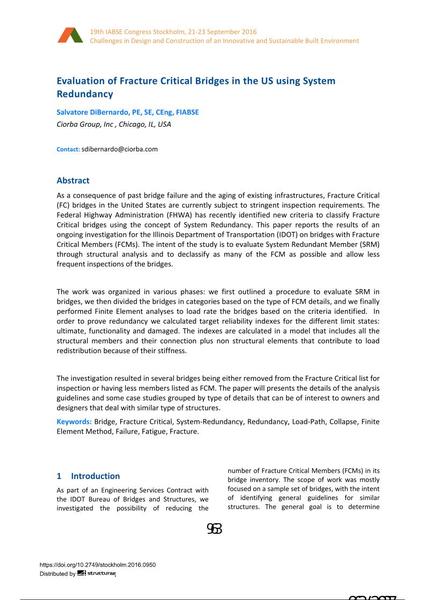Evaluation of Fracture Critical Bridges in the US using System Redundancy

|
|
|||||||||||
Bibliografische Angaben
| Autor(en): |
Salvatore Di Bernardo
|
||||
|---|---|---|---|---|---|
| Medium: | Tagungsbeitrag | ||||
| Sprache(n): | Englisch | ||||
| Tagung: | IABSE Congress: Challenges in Design and Construction of an Innovative and Sustainable Built Environment, Stockholm, Sweden, 21-23 September 2016 | ||||
| Veröffentlicht in: | IABSE Congress Stockholm, 2016 | ||||
|
|||||
| Seite(n): | 963-970 | ||||
| Anzahl der Seiten (im PDF): | 8 | ||||
| Jahr: | 2016 | ||||
| DOI: | 10.2749/stockholm.2016.0950 | ||||
| Abstrakt: |
As a consequence of past bridge failure and the aging of existing infrastructures, Fracture Critical (FC) bridges in the United States are currently subject to stringent inspection requirements. The Federal Highway Administration (FHWA) has recently identified new criteria to classify Fracture Critical bridges using the concept of System Redundancy. This paper reports the results of an ongoing investigation for the Illinois Department of Transportation (IDOT) on bridges with Fracture Critical Members (FCMs). The intent of the study is to evaluate System Redundant Member (SRM) through structural analysis and to declassify as many of the FCM as possible and allow less frequent inspections of the bridges. The work was organized in various phases: we first outlined a procedure to evaluate SRM in bridges, we then divided the bridges in categories based on the type of FCM details, and we finally performed Finite Element analyses to load rate the bridges based on the criteria identified. In order to prove redundancy we calculated target reliability indexes for the different limit states: ultimate, functionality and damaged. The indexes are calculated in a model that includes all the structural members and their connection plus non structural elements that contribute to load redistribution because of their stiffness. The investigation resulted in several bridges being either removed from the Fracture Critical list for inspection or having less members listed as FCM. The paper will presents the details of the analysis guidelines and some case studies grouped by type of details that can be of interest to owners and designers that deal with similar type of structures. |
||||
| Stichwörter: |
Brücke Ermüdung Finite-Elemente-Methode (FEM) FEM Versagen Redundanz Einsturz
|
||||

